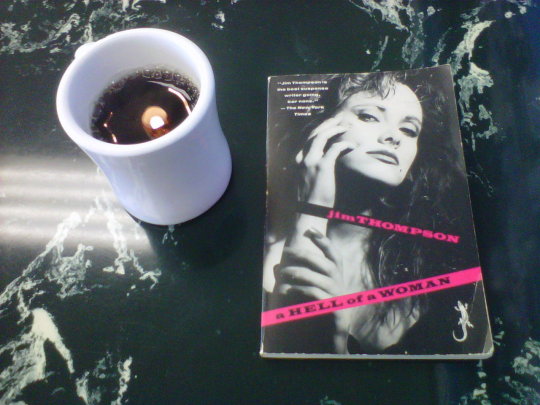#Hard-boiled Crime Fiction
Text
Sorchia and Goddess Fish Present City of Lies
Hard-Boiled Crime Fiction–City of Lies by January Bain
On Thursdays, Sorchia’s Universe joins forces with Goddess Fish Promotions to feature more books in the genres we love. Check out Thursday posts for contests, freebies, and magically delicious mayhem.
Be sure to visit other stops on the Goddess Fish tours to increase your chances of winning prizes.
City of Lies author January Bain will…

View On WordPress
0 notes
Link
But what I had either missed or forgotten about those books was the bitterness of the noir hero. I remembered their affect as being wry, smart-assed, even dry. But the bitterness surprised me.
What surprised me more was the source of that bitterness. The median noir detective is a veteran of either World War I (if the action is set in the interwar years) or World War II (for midcentury settings) and the thing they are just smouldering with rage at is the way that the America they fought for has changed.
They left an America where the right people were running the show — affluent white guys who evinced a priggish moral code. They come back to an America where women, Black and brown people and queers are visible and unashamed of it. They come back to an America where the rich have revealed themselves to be deviants and perverts.
The affect of the noir hero is bitterness over progress.
Much like Edward Neumeier discovering to his dismay that the beloved cracking space-battle novel of his boyhood was actually a reactionary, book-length antidemocratic screed, revisiting those noir novels made me realized that those hard-boiled tough-guys I loved were reactionary creeps.
-Silicon Valley Noir: Red Team Blues and the Role of Bitterness in Technothrillers
#martin hench#red team blues#litcrit#literary criticism#noir#hard boiled#crime fiction#technothrillers
41 notes
·
View notes
Photo

https://archive.org/details/the-mammoth-book-of-private-eye-stories
2 notes
·
View notes
Text
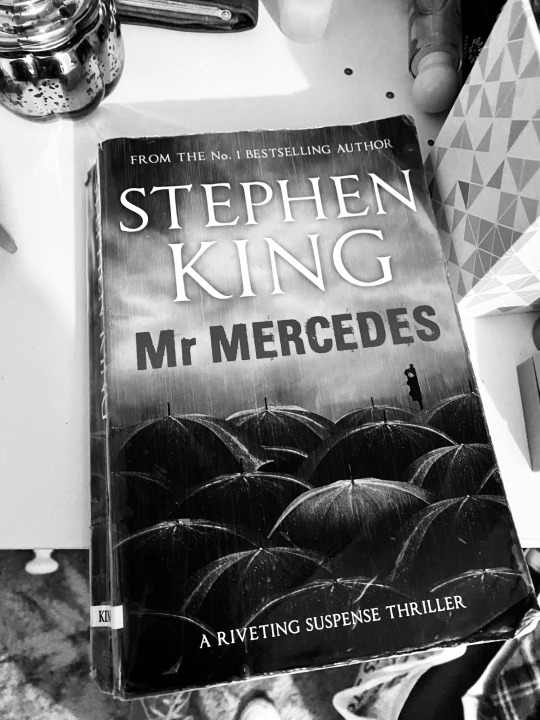
Finished reading: Mr Mercedes by Stephen King
#fiction#reading#books#mystery#thriller#horror#suspense#detective#crime fiction#hard boiled#bill hoghes trilogy#mr mercedes#stephen king
0 notes
Text
"Black Irish Blues" by Andrew Cotto - #BookReview #novella #NovNov23 @brwpublisher @andrewcotto
I was pleasantly surprised by how much I enjoyed this novella. It had a ‘good guy’ protagonist who finds himself immersed in a violent world peopled with ‘bad guys’. It read like a cross between Dick Francis, Raymond Chandler and an episode of the Sopranos. Hard-boiled, but very easy to read with smoothly flowing prose. It was set in an America before 9/11 and the Covid pandemic, during Clinton’s…

View On WordPress
0 notes
Text
NOIR
NOIR is sexy, rough, and available now.
https://www.amazon.com/kindle-vella/story/B0C31Q8PX4
What’s a noir anthology?
It could be crime.
It could be the kind of story that would look perfect filmed in black and white.
It could be sexy.
It could be rough.
Someone’s going to die in this book.
Someone’s going to rip-off some old broads too.
That romance is doomed from the start.
I wouldn’t take that train if I were you.
The cops…

View On WordPress
#Anthologies#crime#DEVIL&039;S PARTY PRESS#FICTION#hard-boiled#hawkshawpress#kindlevella#literary#mystery#noir#Raymond chandler#Writing
0 notes
Text
The weird and wonderful history of Kowloon as a digital interactive space - Part II
This article is the continuation of a previous post.

Any comprehensive history of 20th century Hong Kong is not complete without a chapter entirely dedicated to the architectural and urban planning puzzle that was Kowloon Walled City. Quite unlike any other slum in Asia or elsewhere in the world, the extreme conditions under which its inhabitants lived captured the attention of various international journalists and photographers whose reports of this accidental labyrinth, in turn, inspired some of the most remarkable artistic explorations of our time. In this regard, video games did not remain impervious to the powerfully stimulative imagery, as much a reference today as it was when its hardened concrete walls still stood tall.
Kowloon's Gate Suzaku VR - Jetman - 2017
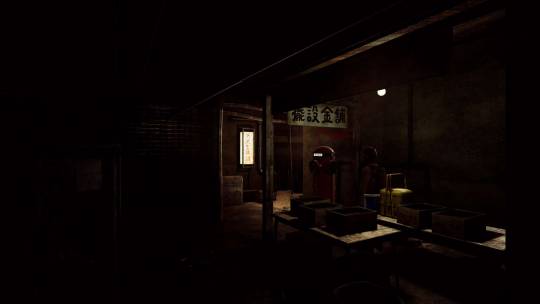
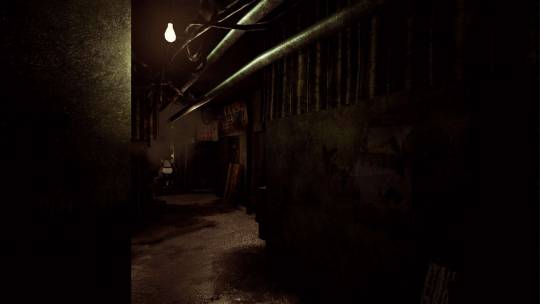
Kowloon's Gate made a most unexpected comeback twenty years after the original episode via the crowdfunded VR project Suzaku developed by Jetman, a studio founded by and composed almost exclusively of ex-SME/Zeque staff. While it is not the remaster many had hoped for, essentially consisting of a walking simulation through some redesigned locations from the original, it does a commendable job in faithfully replicating its instantly recognizable, light-starved alleyways in competent high-definition. It is also the only VR-compatible entry from this list, granting it a degree of uniqueness over its counterparts.
Stranglehold - Midway/Tiger Hill Productions - 2007
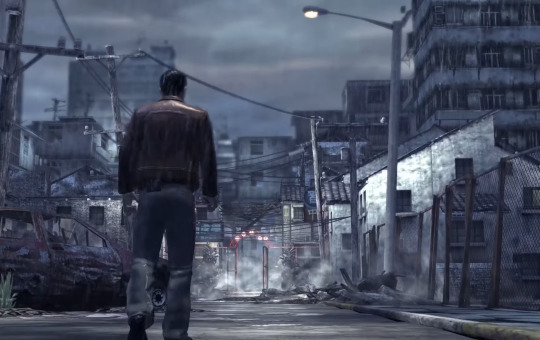
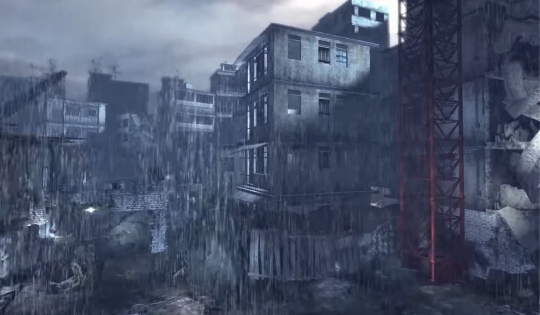
Stranglehold is the result of a collaboration with Hong Kong movie director John Woo, developed as a direct sequel to his heroic bloodshed classic Hard Boiled, featuring Chow Yun-fat in the role of detective 'Tequilla' Yuen in his unending confrontations with organized crime. One of the game's most unforgettable levels, Slums of Kowloon, takes place during a particularly rainy day, seemingly in those last days when the zone had been emptied of residents and demolition work was well underway. The visual representation of the quarter is suitably evocative, its buildings in complete state of disrepair, the remnants of local businesses or places of prayer still discernible from under the piles of steel and cement rubble.
Resident Evil 6 - Capcom - 2012


For all its shortcomings, Resident Evil 6 partly succeeds in taking the first two episodes' concept of parallel storylines and realizing it to a much fuller extent. Its choice of different characters translates into entirely different campaigns, locations and playing styles. The very first scene in Chris/Piers' campaign occurs in the fictional Chinese city of Lanshiang, modelled after real-life Hong Kong. The mayhem in the main streets forces the player to take a detour into a location named Poisawan, which bears a striking resemblance to the Kowloon district. Though an unofficial representation, it is among the most skilled replications of the scenery we find in the vast photographic repository of the area. The degree of minutiae with which the district's haphazard electric installation is replicated, alone, suffices to demonstrate a true commitment to authenticity.
Paranormal HK - Ghostpie Studio - 2020


Few would dispute that Kowloon is, itself, naturally conducive to sentiments of dread and anxiety. Paranormal HK is a 2020 made in China production reviving the defunct neighbourhood in a gripping, blood-curdling contemporary ghost story. The player is the cameraman of a paranormal-themed TV show exploring the zone during the evening of the Zhongyuan festival, a scheme suspiciously akin to that of Akira Ueda's 2004 game, Michigan: Report From Hell. As a result of the thorough research work performed by its creators, as well as the impeccable usage of contemporary 3D graphics techniques to achieve accurate lighting conditions, players may momentarily experience the feeling of walking into a photo of the actual city as it existed in the mid eighties.
Sifu - Sloclap - 2022
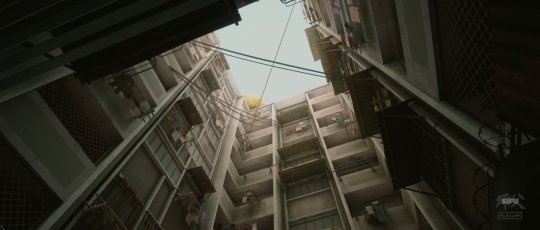
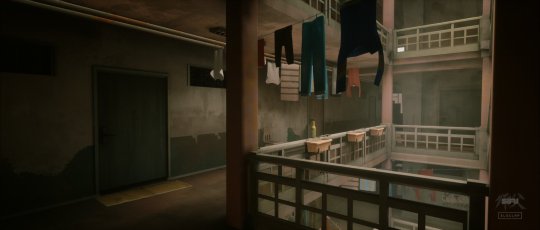

Notwithstanding of its renaissance during the 128-Bit era, the beat 'em up genre is commonly associated with the arcade games of the late 80s and 90s, the period of time when it flourished and, arguably, reached its zenith. The simplicity of controls and ease of access sufficed to attract players to the arcade cabinet, while the frequently extreme levels of difficulty of advanced levels ensured a steady flow of cash for arcade room owners and game development companies alike. Nevertheless, the genre has but perished and, in many aspects, recent years have indeed elevated it to unforeseeable degrees of complexity. Sifu, by Sloclap, synthesizes the elation of digital hand to hand combat simulation with the real-life complexity of mastering a martial art.
As is the case of previous entries in this list, Sifu makes no admitted reference to Kowloon or Hong Kong. However, the designers left little to the imagination in what pertains to their inspirations when taking on the task of constructing the game's environments. Another notable coincidence stems from the fact that this production was made possibly with the support from a celebrated independent game funding group going by the name Kowloon Nights.
Stray - BlueTwelve Studio - 2022


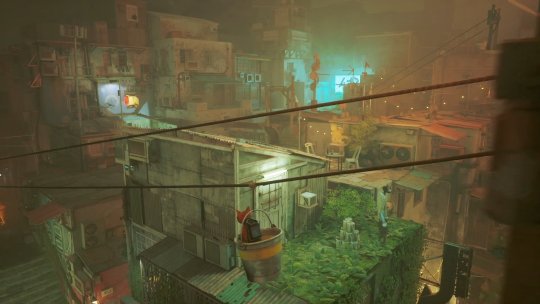
Stray is one of the most revered independent video games in recent memory, and justifiably so. The long development process yielded many benefits, judging from the consistency and attention to detail that engrossed many an avid player. That the main character is singularly charming feline may have played an equally crucial role.
The creators have made no effort to conceal the fact that the notorious Hong Kong district was a pivotal influence to the design of its nameless city. The first indication can be spotted in the game's earliest footage, in which a black cat traverses a street where a particularly conspicuous sign boasted the initials HK. Stray is less concerned with presenting a precise replica of Kowloon than it is about summoning the very essence of its atmosphere. Moreover, in an exquisitely poignant way, its ending lends an entirely new meaning to the term walled city. In the future, robots may well take the place of humans. Invariably, the Walled City is no more.
Slitterhead - Bokeh Game Studio - Work in Progress


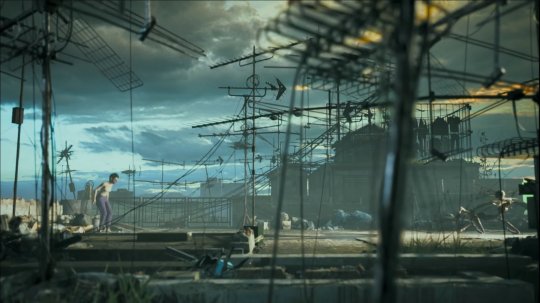
An sequence of unconscionable mistakes from the part of Sony Computer Entertainment's management galvanized Keiichiro Toyama to part ways with Japan Studio, as it once was, and establish his own game production label. Their debut title, Slitterhead, is described as a grotesque survival horror experience, a genre within which the author moves with matchless ease.
Among the few certainties regarding this project is the fact that it will take place prominently - if not exclusively - within the Kowloon City province. A wide variety of aspects included in the preview footage leave the viewer optimistic as to this being one of the most accomplished portrayals of the district ever seen in a video game. Subtle yet telling signs already demonstrate the creator's in-depth knowledge of the quarter's architecture and history.
Take, for instance, the suggestive image of the airplane flying mere meters above the top of the buildings. Although the growth of Kowloon was for the most part ungoverned, buildings did not rise above a certain height, even as inhabitants claimed for increased availability of space. This is due to the fact that airplanes landing at the nearby airport would be required to make their descent at relatively low altitude, performing a tight curve as they soared just above the enclave, thus preventing construction from expanding upwards. Another scene shows a child playing on the rooftops of the buildings, which once again is consistent with the documented habits of residents who, starved for sunlight and open space elsewhere within the city limits, had little alternative than to take the stairs all the way to the top.
Warehouse Kawasaki Arcade

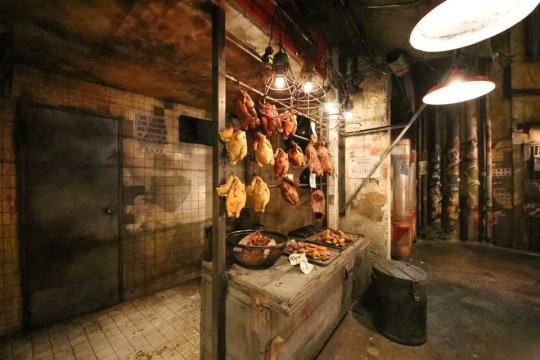

I would be remiss not to make some form of allusion to Warehouse Kawasaki, an arcade built to replicate the Walled City with unthinkable detail. Though its ultimate purpose was for visitors to engage in digital entertainment, the venue was scrupulously put together. Point in fact, many of the objects used in the construction of the five floor amusement centre were imported directly from Hong Kong. Like so many other Japanese arcades, it closed its doors in 2019.


In recent years, a rather similar initiative was taken by the Chinese in their attempts to build unique mall spaces. The 文和友 malls in mainland China, found in Changsha, Guangzhou and Shenzhen, attempt to reproduce the walled city aesthetic. Local residents inform me that these are increasingly lacking in foot traffic, for which reason the majority of their stores are closed.
Other digital replicas of Kowloon

A number of other videogames set in or deriving inspiration from Kowloon could not be featured in this article.
A frequently cited reference in this context is the action/adventure game Fear Effect, one which I emphatically dispute. No doubt remains as to it being located in a futuristic version of Hong Kong, yet I could discern no parallels with the walled city, save for those scattered second-hand visual motifs that were no doubt imported from sci-fi classics such as Blade Runner or Ghost in the Shell.
The Utelek Complex stage of Deus Ex: Makind Divided presents a similar situation, where the overall atmosphere of the futuristic favela bears some resemblance to Kowloon, without meeting the specificity quota that would warrant a more comprehensive exploration.
The 2004 Shout! original Kowloon High-School Chronicle for the PS2 is a unique case, in that it borrows the city's name despite taking place in a massive, Tokyo underground dungeon that is later revealed to be a maze-like Egyptian pyramid. The odd choice of title remains unclear.
Shadowrun: Hong Kong game (screenshot above) contains a very direct mention of Kowloon as the place in which an entire episode comes to pass. Another project still in development, Kowloon's Curse (screenshot below), is following the lead of many popular independent horror games in recent memory by using a visual design and structure that elicits memories of the late Playstation/early Dreamcast era. A short prequel episode was made available earlier this year, for free.
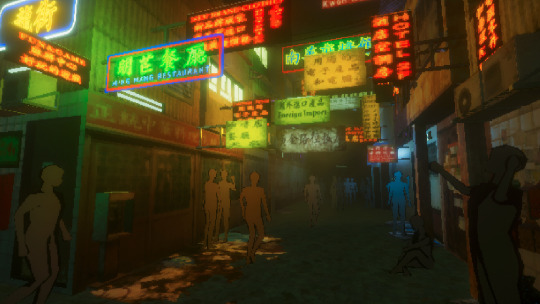
Additionally, I refrained from mentioning the Kowloon maps in Call of Duty: Black Ops or Counter-Strike: Global Offensive, as I perceive both games to be insufficiently relevant to merit study or contemplation.
A space that refuses to be forgotten
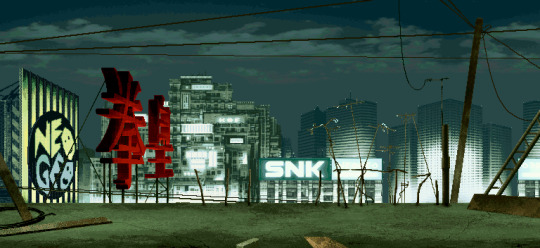
(China rooftop stage from The King of Fighters 2003)
It would be a gross overstatement to claim that Kowloon is a recurring location or level design motif in videogames. The relationship between digital games and the real life ghetto has been one of sporadic references. What makes the subject so engrossing pertains to the quality of the relationship, particularly that of a small cadre from among the titles featured in this article. Kowloon's Gate was one of the most relevant game creations of the 32-Bit era, a game deserving of reverence and cult following inside and outside Japan. Likewise, Shenmue II is the second instalment of a truly ground-breaking and highly advertised series whose production costs alone were unmatched until quite recently.
Moreover, this is an affair that is far from concluded. The unexpectedly high number of allusions to Kowloon in videogames released or revealed just last yet demonstrates that its aesthetic is still very much present in the minds and hearts of artists and designers working in the field. The walled city lives on as a digital demarcation that is certain to resurface time and again in years to come.
#kowloon's gate#kowloon's gate VR suzaku#jetman#stranglehold#john woo#kowloon walled city#hong kong#resident evil 6#poisawan#paranormal hk#ghostpie studio#sifu#kowloon nights#stray#slitterhead#bokeh game studio#keiichiro toyama#Warehouse Kawasaki#arcade#文和友
155 notes
·
View notes
Note
Whenever antis still spout that "Jon never forgave Sansa!" I think of the last scene between them and how he ended up hugging her so hard I thought he might burst. Like he was genuinely sad he would never see her again. If he never forgave her, you think he would have been stoic when she hugged him and kept his arms to his side, but he didn't. If the script said he didn't forgive her, then Kit's acting choices were interesting. lol
You can't come to me with show!questions, I'll get grumpy and bitter! 😂
The fact that she asked for forgiveness at all is enough to make my blood boil. What for? Apart from the D&D Sansa Apology-and-Thank-You Tour that began and ended with Jon for entirely fictional "crimes".
The visually beautiful hug is kind of drowned out by the incoherence of it all. It looks pretty and obviously emphasizes how much Jon cares about Sansa, but at this point I, the viewer, no longer care about their relationship because it's devoid of consistent connection. Lots is implied but nothing of meaningful substance is shown.
I'm very sorry, this is probably not the answer you were looking for, but show!Jonsa has really lost its appeal over time for me because it essentially boils down to lots of people caring about Jon without holding him accountable and Jon being a completely opaque blob we are meant to decipher by the power of micro-expressions or body language.
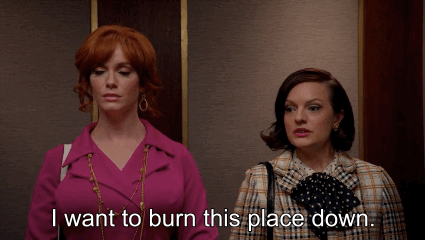
27 notes
·
View notes
Link
Going back to old favorites is a weird exercise. I remember reading an interview with Edward Neumeier about his script for Starship Troopers, describing how he remembered the original Heinlein novel as a kind of fast-paced action-adventure thriller about massive set-piece battles with alien monsters. But when he actually went back and re-read the novel, he discovered while that those battles make up the beginning and end of the novel, the meat of the book is a bunch of boring lectures about whether only soldiers should be allowed to vote.
I remembered those hard-boiled novels as plot-forward, pacey books about two-fisted heroes beating all the odds to defeat deliciously evil villains. I thought of them as Ur-pulps, as William Gibson told The Paris Review:
The only kind of ghetto arrogance I can summon up from being a
science fiction writer is, I can do fucking plot. I can feel my links
to Dashiell Hammett. If I meet some guy who subsists on teaching
writing in colleges, and if there’s any kind of hostility, I think, I
can do plot. I’ve still got wheels on my tractor. The great thing is
when you’re doing the other stuff and you whip the plot into gear,
then you know you’re driving something really weird.
Gibson’s not wrong here. These books have got wheels on their tractors. They can do fucking plot.
-Silicon Valley Noir: Red Team Blues and the Role of Bitterness in Technothrillers
#martin hench#red team blues#science fiction#sf#litcrit#literary criticism#noir#hard boiled#detective fiction#crime fiction#technothrillers
14 notes
·
View notes
Text
Philip’s Juxtaposition
You know what’s ironic to me? Philip says that the Boiling Isles and the inhabitants of the Demon realm have “warped [Luz’s] sense of reality.” Ha! that couldn’t be any further from the truth.
Living in the demon realm and interacting with everyone on it has actually helped Luz embrace reality for what it is. For better or worse. She wanted to be a hero, well had to face all the dangers, sacrifices, and heartbreak that come with it. She wanted to learn magic, well that certainly wasn’t as easy as she thought it’d be.
Her magic along with everyone else’s doesn’t just come from thin air by chanting a spell or waving a wand around. In place of a magic bile sac she had to work extremely hard and practice patience to discover and learn how to use every one of her glyphs.
She wanted to make friends well she had to try and acknowledge the difference between an actual person and a fictional character along with the scenarios that come with them. In the second episode she whole heartedly embraced the trio of yes men who sang her praises as she embarked on a fake quest for a wizard, but her real friends aren’t like that. They’re weirdos just like her with real personalities, opinions, and interest. They themselves had their own problems and made their own mistakes. Sometimes Luz’s enthusiasm to follow a fictitious narrative put her friends in danger or hurt them in some way and she had to own up to that.
In the end what she told her mom is true. She’s learned so much from the Boiling Isles and it’s helped her grow into a strong, mature, and dependable young woman. In return she’s helped to improve the lives of everyone she meets.
Philip on the other hand is a different story. This man’s time in the Demon Realm has all but driven him to insane because he has chosen to relentlessly pursue a complete and total fantasy of his own. He has decided it’s his destiny to destroy all of witch kind, return home triumphant and to be appointed Witch Hunter General. In reality he’s wasted 400 years in a world he hates only to return to one he doesn’t recognize all while he himself is unrecognizable.
It’s like Luz said he’s barely human anymore. Philip has been alive a lot longer than he should be. To sustain himself he consumes palisiman souls which give him the ability to transform into a monstrous entity. Then proceeds to convince Hunter and many others that this is because he was cursed by “wild magic.”
He killed his brother because he literally couldn’t accept the fact that his brother had changed and come to embraced the Boiling Isles. Instead, he proceeds to create Grimwalkers. Clones of his deceased brother in the hope that he’ll mold them into what he believes to be the perfect witch hunter. Only to murder them over and over again. Never fully acknowledging his guilt or that he may derive some sick sort of pleasure from doing so. Instead calling it Justice for a repeated betrayal.
Dude doesn’t even go by his original name. He had to change it after he got run out of every town on the Boiling Isles. Most likely due to some crime or misdeed he committed. Then proceeds to force a connection with Luz by psychologically torturing her into addressing him by his given name.
Even Hollow Mind shows us just how warped his mind really is. There’s a grand looking hall of memories that hides and embellishes the reality. But hidden under the veil we see just how eerie and dilapidated his mind truly is. Even his inner self is a juxtaposition. A child playing pretend. Philip has not (read: will not) accept reality for what it is and disregards anyone who tells him different. I’m interested to see what consequences come of this debilitating mindset.
#the owl house#toh meta#meta analysis#owl house#philip whittebane#emperor belos#owl house spoilers#the owl house spoilers#luz noceda#toh hunter#hunter toh#grimwalkers#palisman#caleb whittebane#fantasy vs reality#toh#toh analysis#character analysis#character arcs
410 notes
·
View notes
Text
Gathering of the Greatest Gumshoes - Number 9
Welcome to A Gathering of the Greatest Gumshoes! During this month-long event, I’ll be counting my Top 31 Favorite Fictional Detectives, from movies, television, literature, video games, and more!
SLEUTH-OF-THE-DAY’S QUOTE: “How do you think this all works? By being big and being bad.”
Number 9 is…Bigby Wolf, from The Wolf Among Us.
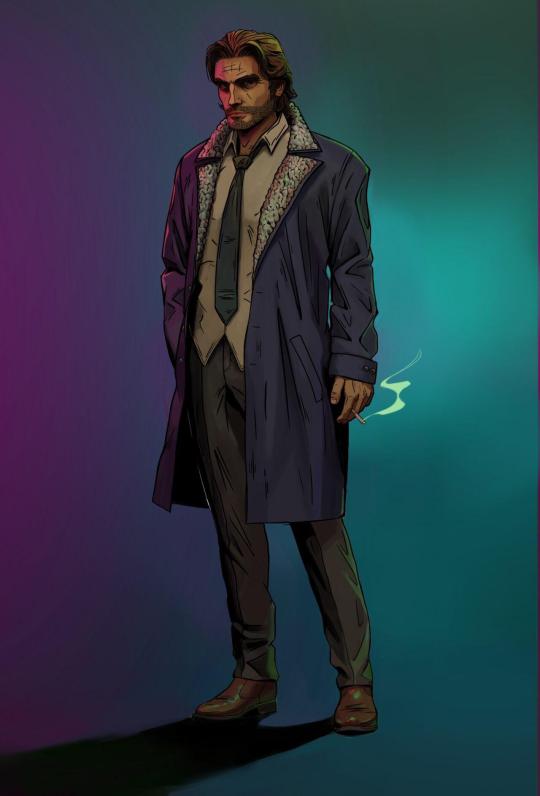
“The Wolf Among Us” is a video game made by the now-defunct developers Telltale Games. The game was based on the comic series “Fables.” I’m going to come right out and say it: I have never read the comics, and I have basically no real knowledge of them or how the characters and lore in them may differ from the established points in “The Wolf Among Us.” HOWEVER, very thankfully, the game is able to stand up on its own two feet regardless, and so are its characters, so even someone who has basically no knowledge of the source material can still enjoy it.
The game is a sort of choose-your-own-adventure sort of deal; a point-and-click adventure where the player’s choices every step of the way affect how the story plays out, the kinds of relationships you form with other characters, and so on. Some choices are more important than others, but virtually every choice of note is worth pondering. The plot is a combo of film noir crime story and dark fantasy: it takes place in a world where various characters from the world of fiction, after their universe was mysteriously destroyed, have fled to the “real” world in order to seek refuge. They’ve established their own city, called “Fabletown,” where real world problems combine with fantastical adventures, as they struggle to build new lives and survive in this different universe, and hide their identities from the “normies” who exist beyond the borders of the city.
The main character is Sheriff Bigby Wolf. Bigby, as you may have guessed from his name and the title, is the Big Bad Wolf of fairy-tale infamy himself. In the world of the game, Bigby is a werewolf, who can transform from a human to increasingly more wolf-like forms, his true and ultimate form being a GIGANTIC feral beast bigger than elephant, able to create hurricane-force winds with his breath alone, and more than capable of swallowing a person whole. Needless to say, with this kind of setup, and his reputation as one of the greatest, most archetypal villains in history, Bigby isn’t exactly a popular Sheriff. Many fear or distrust him, and those that don’t typically still keep their distance for one reason or another.
Because of the playstyle of Telltale games, Bigby’s exact personality can shift depending on the choices the player makes: he can be sort of a gentle giant, who looks rugged and tough but really isn’t that bad. In contrast, he can be much more morally and ethically dubious, an anti-hero closer to Dirty Harry, who walks a very fine line between a man and a monster. However, regardless of the choices you make, a few things remain constant: Bigby’s general demeanor is that of an almost stereotypical noir-style detective. He’s gruff, grumpy, coarse, and can’t seem to go five seconds without having a cigarette. He’s often cynical and sarcastic, very much the sardonic hard-boiled sleuth. The character is voiced by Adam Harrington, and he does a phenomenal job giving Bigby the airs of such a great archetype, while also injecting vulnerability and sympathy into his portrayal.
The most notable constant of all, however, is Bigby’s motivations: even if you make him especially nasty, it’s usually pretty clear that this Big Bad Wolf is racked with guilt over his past. He knows the stigma that hangs over him is VERY well-deserved, and he legitimately wants to try and help people and make things better. Even when he makes questionable decisions, the majority of them are still justifiable in some fashion or another. He doesn’t want to be seen as the bad guy anymore, he wants to try and start a new life. It’s up to the player to determine if Bigby is truly able to put away the vicious, cruel, beastly sides of his personality and turn over a new leaf, or if his efforts and desires are all in vain.
Even though Telltale officially closed down in 2018, the first game was so popular that it was eventually revived for an upcoming sequel, made by the remnants of the Telltale staff with help from AdHoc Studios. The new game is set to release sometime this year, though no official release date has been given. Whenever it arrives, I look forward to seeing how Bigby’s story continues, and what new paths and new cases will await him in the future.
Tomorrow, the countdown continues with Number 8!
CLUE: “Just one more thing…”
#list#countdown#best#favorites#top 31 fictional detectives#gathering of the greatest gumshoes#number 9#bigby wolf#bigby#the wolf among us#telltale games#video games#fables#comics#big bad wolf#mystery#noir#fantasy#fairy-tales
13 notes
·
View notes
Note
The question about photographs and pen names got me thinking ... like, some writers write under more than one pen name, right? Like someone might separate YA form erotica or romance from their horror fiction. So if people just use their own picture, how are these identities kept separate? Also, wouldn't it just take a few people who know the author to comment "hey, that's not (pen name), that's (real name) who lives in my town" and the cover is blown? Like why hide the name, not the face?
Usually when an author is using multiple pen-names, they aren't trying to hide their identity -- they are just "rebranding" for different audiences. Examples:
E. Lockhart writes YA. Emily Jenkins writes picture books and chapter books. They are the same person, their websites link to one another, and they use (different) official headshots -- but still it is clearly Emily, she's not in disguise or anything. It's just different branding for different audiences; I'm sure the thinking is, she doesn't want a 6 year old TOYS GO OUT fan to google her other books and start reading WE WERE LIARS, yanno? Or for a teen LIARS fan to be stumped as to why their auto-buy author suddenly delivered them a picture book about lemonade.
Zoraida Córdova writes YA fantasy. Zoey Castile writes sexy romance. Same person, not hidden, just different brands for a different audience.
Sometimes it's a very famous person and they ARE "hiding their identity" to begin with so that their work will not be conflated with their other, famous, very different work -- but the "secret" is a whole schtick, like "ooooh, this VERY FAMOUS person doesn't want us to know who it isssss" -- and it inevitably comes out and results in a ton of extra publicity, soooo... IS that a "secret" or a publicity move? Hm. Examples:
Nora Roberts is a prolific bestselling novelist. JD Robb is a hard-boiled crime writer. (This one WAS a secret, at first, but then the secret was out, and now, they are openly the same person, JD Robb's picture is Nora in sunglasses, and when you google JD Robb, Nora comes up!)
JK Rowling (needs no link or introduction) writes as Robert Galbraith (google it if you don't know!). Same deal, she didn't want her Important Adult Mysteries to be tainted by Harry Potter's fame, so she created a new "secret" identity... etc etc.
Point being, if it is a deliberate Just Creating A Different Brand, Not a Secret, then your neighbor seeing the pic wouldn't matter. If it IS a "secret"/publicity stunt, then there wouldn't be a pic to see, but then eventually the "secret" would be revealed anyway.
The third version is the Truly Anonymous author -- there are a few people like this, who use pen-names and their identity is truly Secret. Elena Ferrante is one such author, and people are forever trying to unravel the mystery behind her identity. And some books are published literally by "anonymous" (though these days, the secret usually comes out at some point!) -- but this is HIGHLY unusual!
9 notes
·
View notes
Text
the impact of crime fiction !!
step into the world of crime fiction, where detectives chase elusive killers and villains lurk in the shadows !! from bestselling novels to blockbuster movies, crime fiction captivates us with its gripping narratives and morally complex characters. but how does it influence our perceptions of crime, law enforcement, and justice ??
🔍 historical evolution:
crime fiction has a super rich history, tracing back to ancient bible tales (one thousand and one nights) and evolving over centuries. from sherlock holmes to hard-boiled (edgy) detectives, the genre reflects societal changes and cultural shifts, shaping our understanding of justice and human nature !!

💬 critiques and controversies:
while crime fiction provokes thought and sparks dialogue, it's not without controversy. critics question its portrayal of violence and the glamorization of criminality (2012 Aurora Theater shooting, the suspect called himself "the joker"), and also romanticization of criminality (think bonnie and clyde). yet the genre continues to thrive, captivating audiences and sparking important discussions about social issues.

💡 benefits of crime fiction:
crime fiction isn't just entertainment- it inspires empathy, promotes critical thinking, and sheds light on pressing social issues !! Even recruits drawn to law enforcement through its romanticized portrayals bring passion, creativity, and dedication to their roles.
(i'm majoring in criminal justice bc of hannibal nbc 😭)

📝 conclusion:
crime fiction serves as a lens through which we explore the complexities of crime and justice. by engaging with its narratives, we gain valuable insights into human nature, morality, and the challenges of navigating moral ambiguity in society !!
#crime fiction#criminal justice#true crime#sherlock holmes#detective#silence of the lambs#nbc hannibal#edgar allen poe#joker#batman#romantization#dc comics#english class#research paper#college#im actually so passionate abt this
6 notes
·
View notes
Text
Loup-garou and Lycanthropes and Hexenwolves, Oh My!
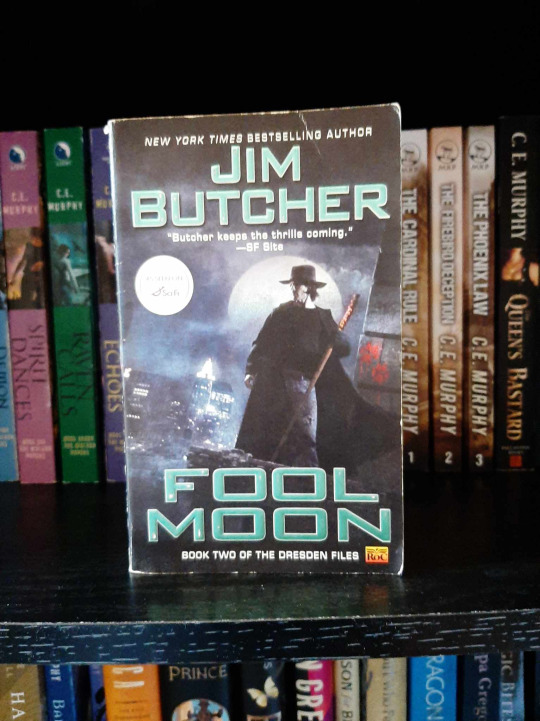
Ok, so I figured that a noir detective inspired, edgelordy series needed a more aesthetic shelf choice, so as we go forward with the Dresden Files, the photos are gonna be on the black bookshelf.
*Atmosphere*
So, for anyone who is just finding this post, you might want to check out this post for my feelings on Dresden and what my Dresden tragic backstory is, and this post for my overview of Storm Front, because I'm not going to rehash any of that in this post. The TLDR is that I'm working my way through the Dresden Files because until Peace Talks and Battle Ground, I was a megafan and there's a reason for that. These reviews--for want of a better word--are exploring what was good and what were red flags from the get-go. So with the business out of the way, let's talk Fool Moon!
In a classically punny Dresden Files title, this book tells us with its whole chest what this book is going to focus on: Werewolves.
Now, thanks to the excellent work of Red from Overly Sarcastic Productions, I get to link you to this video on werewolves instead of doing a lore overview myself. Many thanks, Red! Butcher manages to really take a ton of different threads of werewolves and gives multiple threads and lore lineages page time. It's actually really cool, because Dresden Files does fantasy lore exceptionally well.
What I also find really fascinating though, is how that fantasy lore is mixed with non-fantasy genres. Let's back up a little and define some parameters and some genre stuff.
The Dresden Files series (particularly the early books) draw from urban fantasy, noir detective fiction, and hard-boiled detective fiction for their genre. And if there was ever a book series that proved that genre is made up and that there are no hard boundaries between genres, this is it. To make it even more interesting, the Dresden Files mix three subgenres. So simply put, urban fnatasy is just putting supernatural elements in a contemporary urban setting. Harry Dresden is a wizard in Chicago. Boom, urban fantasy, done. Noir in general goes back and forth in terms of whether it is a mode (something that defines a mood or tone) or a full-on subgenre, but generally speaking, if we are describing something as noir, we mean that it leans towardds darkness (in both theme and subject matter) and we often mean that is has a mixture of sex and violence. Finally, we have hard-boiled detective fiction, which was traditionally characterized by their antihero protagonists, their corrupt legal systems, and their Prohibition setting. However, the setting and the organized crime antagonists are often negotiable, and the Dresden Files negotiates the hell out of that to have Marcone's organized crime syndicate as well as a few different fantasy factions that function as organized crime if you squint a bit.
To hit all the main points of all three of the subgenres effectively while explaining werewolf lore is really genuinely impressive. That said, the subgenres are what can potentially make Dresden Files hard to read. Noir and hard-boiled detective fiction have misogyny and patriarchy and paternalism and violence against women deeply embedded in them. Kim Delaney is ripped to shreds by a man she is trying to help because Harry gets all paternalistic about his "sometimes apprentice" asking about a type of magic she is absolutely not ready for, and instead of digging into WHY she's asking this, he gatekeeps the information, directly leading to her death. This is steeped in noir and hard-boiled detective fiction generic conventions, and...there's a tendency to sort of write it off as "oh, it's just part of the genre" and just keep reading because the fantasy lore and plot are compelling. And yeah, I fully excused this stuff in early books for exactly that reason.
But here's the thing: Genres can change. You as author can change them, and we do not have to double down on misogny and violence against women and paternalistc patriarchy. We just don't.
I'm probably not talking enough about the plot and characters, which after the lore are the things that keep you reading the early Dresden Files books, because the first three books are aggressively ok as novels, and four shows an improvement and five is a sharp upswing in quality, but the first three books are...fine. They're fine. They're interesting enough in their lore to keep you reading, and the writing is competent if not as polished and clearly voiced as later books would be. Like genuinely, when I do Dresden rereads, I tend to start at either Death Masks or Dead Beat. And these days I tend to stop at Skin Game, because I will die on the hill that Skin Game is the pinnacle of Dresden.
...And I still didn't manage to get to the characters and plot in that paragraph. Look, we're still very much at the point in the series where Harry and Murphy are carrying the series--although Marcone has also always been a strong character--but we do meet Billy Borden and the Alphas in this book, and they will recur throughout the series and develop in some really interesting and compelling ways.
I think that's where we're going to leave it for this book! I have a hard time recommending Dresden Files these days, but if you want to pick them up, I'm not going to say don't. There are worse things to pick up, and these can be fun, if you're willing to turn off your critical thinking for a few hundred pages.
#jim butcher#dresden files#the dresden files#harry dresden#fool moon#adult fantasy novel#urban fantasy#crime fiction#noir fiction#hardboiled detective fiction#books & libraries#books and reading#books and novels#books#book recommendations
14 notes
·
View notes
Note
"You would be surprised if you knew how easy it is to hide human remains in pastries"
^this was the ending line to one of your recent works. What I feel is that this is such a common theme in terms of "getting rid of the body" in fiction. But what I really want to know is how would one do this?
Like yeah, there's a lot of flesh that can be baked through meat pies like in Sweeney Todd, but what about the bones? and how does one clean up excrement?
Also, what is the person is diseased? Clearly when it comes to cannibalism, you need to avoid the brain due to Kuru, but what about the other parts.
I have so many questions that I'm not even sure if I want answered lol.
Ok, since this is a more "gore-y" thing than what is usually on my page I put it below the cut. Please don't do what I write here. Please don't read this if you feel uncomfortable.
Before I start: OF COURSE I have never done this before. All I do is like to watch crime documentaries. (Please only watch those that handle the victims with care and respect and don't romanticise the person behind it all!) So my knowledge is basing on theories and past events, not personal experience.
To begin, human bodies are incredibly fragile and thus easy to dispose. For example, you can "cook" a human away, only leaving bones behind. Leave a deceased body long enough in boiling water and they will dissolve away. Human bodies are practically a huge lump of cells and everything that can get rid of, let's say a chicken, can also get rid of a human. We actually are wonderful fertiliser for plants. Big, easy to be broken down into what we are made of. You get my point.
So our meat is not that much of a problem. You can even make soap with us. Please don't.
Bones are also pretty easy to dispose of. It's just a question what tools you have at your disposal. Did you know that bones are, material wise speaking, not that stable. What does make bones as uh... not so breakable is how they are build. It's hard to describe how a bone is build on the inside but that's basically what makes it so strong. If you break the bones apart after, let's say you boiled the body off of it, you can grind them more and more down. I would even theorize that you could grind it into powder. Or you could just burn them. Ash is easy to dispose of anyways.
Excrement is also easy to get rid of. Like I said, human bodies are great fertiliser. That also includes our waste. Just because we can't use certain things doesn't mean that the same counts for our surroundings.
Brain? Uh... not so sure there but I guess you shouldn't eat it. But I could imagine it's rather easy to get rid of one. Burry it somewhere. Nature will take care of the rest. Or burn it. Also always an option.
Diseased bodies should not be consumed. Whether the is of a human or an animal. In that case you can really just get rid of them.
I think I already made it clear but please don’t do any of those thing. Please don’t.
21 notes
·
View notes
